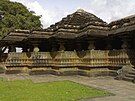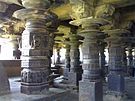Hangal
Hangal
Viratanagara | |
|---|---|
town | |
 Hangal Tarakeshwara temple | |
| Coordinates: 14°46′01″N 75°07′34″E / 14.767°N 75.126°E | |
| Country | |
| State | Karnataka |
| District | Haveri |
| Lok Sabha Constituency | Haveri |
| Nearest Large City | Hubli-Dharwad |
| Elevation | 555 m (1,821 ft) |
| Population (2011) | |
• Total | 28,159 |
| Languages | |
| • Official | Kannada |
| Time zone | UTC+5:30 (IST) |
| PIN | 581 104 |
| Telephone code | 08379 |
| ISO 3166 code | IN-KA |
| Vehicle registration | KA-27 |
| Website | hanagaltown |
Hangal, formerly known as 'Viratanagara', is a historic town in Karnataka. It is 80 km (50 mi) away from Hubli through NH 766E.
Location
[edit]Hangal lies about 75 kilometres (47 mi) south of the city of Hubli-Dharwad, about 30 kilometres (19 mi) west of the Tungabhadra river and east of the Arabian Sea. It is located on state road one, running north to south. A nearby body of water is the Anakere lake. The town is on level terrain in an agricultural district.[1]
History
[edit]Hungal is recorded as Panungal in early documents. It was once the capital of a feudatory of the Kadambas.[2][3][4][5] The Kadambas was an ancient dynasty of south India which ruled the region of the present-day state of Goa and nearby Konkan region from around AD 485 until the 11th century. They built temples in Hangal in the Jain tradition.[6] In medieval epigraphs, it is known as Viratakote and Viratanagari, that is the fort and the city of Virata. According to local legends, it is believed to be the place where the Pandavas spent the thirteenth year of their exile.[7]
Hanagal is also known for Agnihotra (three Kunda shroutagni) which was practised by Shrotriya Samrat Brahmashri Chayanayaji—Girishastri Kashikar—for seven generations till 1973.
Around 1031, the Hoysalas took and held Hangal. In 1060, Mallikarjuna of the Shilahara laid siege to Hangal.[8]
In the 12th century, Hangal was held by the Kalalyani Chalukyas, rulers of the Deccan.[9] The Chalukyas built temples in the Gadag architectural style, from grey-green coloured chloritic schist.[5]
On 14 July 1800, English forces took Hangal from Dhoondia Punt Gocklah, a Marhatta rebel deserter.[10]
Demographics
[edit]
As of 2001[update] India census,[11] Hangal had a population of 25,011. Males constituted 51% of the population and females 49%. Hangal had an average literacy rate of 64%, higher than the national average of 59.5%: male literacy was 67%, and female literacy was 60%. 14% of the population is under six years of age.
Politics
[edit]Srinivas Mane of Indian National Congress party is the MLA representing the Hangal (Vidhana Sabha constituency) since 2 November 2021.[12]
Transport
[edit]Hangal is approximately 370 kilometres (230 mi) from Bengaluru and 40 kilometres (25 mi) from Haveri. The town can be reached from Bengaluru via Chitradurga and Haveri and from Dharwad via Hubli and Shiggaavi. The nearest rail head is at Haveri (railway station code HVR).
Temples
[edit]Hangal has many historic temples related to the Chalukyas and the Hoysalas.
Tarakeshwara Temple
[edit]
The Tarakeshwara Temple is a large structure decorated with images and pillars dating to the Chalukya era in the mid-12th century and dedicated to the Hindu god Shiva in his form as Tarakeshwara.[13][14][15] The images include scenes from the Ramayana.[16]
The outer walls are designed with miniature shikaras of both Dravidian and Nagara style. The pillars of the open main hall are lathe turned wood. They have a bell shaped section and other decorations including elephants and diamond shaped motifs in bands. The elephants are carved so there appears to be a space between their trunks and the pillars. The band motifs vary in detail. The temple main hall has a large domed ceiling. It consists of concentric circles of cusped mouldings. At the apex, the ceiling falls rosette or pendant design. The overlying roof is a stepped pyramid shape.
Nearby is the ramal, an octagonal piece of stone in a corbelled lotus shape. It is 30 feet (9.1 m) and is supported on eight pillars. There are memorial stones carved with religious (Mastigallu) and military (Veeragallu) scenes. Eight of them are guardians of eight cardinal points.[17]
There is a sanctuary adjoining the main hall. The Nandi pavilion rests on twelve pillars and contains balcony seating. There is also a Ganesha temple of the Nagara style (northern curvilinear) shikhara (miniature temple decorations.)
Jain temple at the fort
[edit]
The Jain temple in the Hangal fort is located on the premises of the department of horticulture. It dates to 1150 AD.[18][19] The temple in the Hoysala style is beautifully decorated but there is need of conservation and restoration.[20] The temple was built on a stepped plan. It had an open hall and sanctuary, now in ruins. The sculptural decoration included flowers, garlands, torana, animals, birds and deities. It was especially elaborate in the upper portion of the walls. The temple walls are also decorated with thin pilasters. The open hall has lathe turned pillars.
Lord Sarahunaath Temple
[edit]Lord Sarahunaath temple in the Suraleshwara near Hangal.
Veerabhadra Temple
[edit]The Veerabhadra temple is also located at the Hangal fort. Although highly decorated, it is in need of restoration work.[21]
Billeshwara Temple
[edit]
The Billeshwara temple is in the Hoysala style. This temple has elaborately carved jambs on the doorframe of the garbhagudi. At the bottom of each side, there are five carved figures. Manmatha is in the central projection. Rati is at his side. Daksha (the goat headed deity) is also present and all are flanked by attendants. The temple has a sanctuary face which is incomplete. The temple outer walls are decorated with designs of temple towers and carved diamond shaped depressions. The square panels show carved serpents with intertwined tails, animals, musicians, and foliage.
Photo Gallery
|
|---|
|
See also
[edit]References
[edit]- ^ "Hangal, Karnataka map." Google.com Accessed 9 November 2015.
- ^ "Handbook of Karnataka." Archived 7 December 2008 at the Wayback Machine Gazetteer Accessed 11 August 2008
- ^ "The Kadambas of Hangal." Nupam.com Accessed 11 August 2008
- ^ Moreas G. "The Kadamba Kula." at Google books.co Accessed 9 March 2009.
- ^ a b "The Kadambas of Hangal." Archived 24 July 2008 at the Wayback Machine Prabhu.50g.com Accessed 11 August 2008.
- ^ "General view of a small ruined Jain temple in the Fort, Hangal." Archived 21 May 2011 at the Wayback Machine At Google Books.co Accessed 17 October 2008.
- ^ George M. Moraes. The Kadamba Kula: A History of Ancient and Mediaeval Karnataka. Asian Educational Services, 1995 - History - 504 pages. p. 105.
- ^ Moraes G. "The Kadamba Kula: A History of Ancient and Mediaeval Karnataka." Asian Educational Services, 1995 p129. ISBN 8120605950, 9788120605954.
- ^ Pigou W. "Hungul, a temple." Archived 21 May 2011 at the Wayback Machine 1857. At Bl.uk online gallery. Accessed 13 March 2009.
- ^ Wellesley A. "The Dispatches of Field Marshal the Duke of Wellington, K. G. During His Various Campaigns in India, Denmark, Portugal, Spain, the Low Countries, and France: India, 1794-1805." J. Murray, 1834 p69 at Google Books accessed 8 November 2015.
- ^ "Census of India 2001."[permanent dead link] Census commission of India. Accessed 1 November 2008.
- ^ "Hanagal Bypoll: Setback for K'taka CM Bommai in Home Turf, Cong Win Boosts Party's Morale". News18. 2 November 2021. Retrieved 2 November 2021.
- ^ "Tarakeshwara temple." Archived 21 May 2011 at the Wayback Machine Bl.uk online gallery. Accessed 17 October 2008.
- ^ "Alphabetical list of monuments - Karnataka - Dharwad." Asi.nic.India accessed 13 March 2009.
- ^ "The Architectural Antiquities of western India." Archive.org Accessed 17 October 2008.
- ^ "General view from the south-west of the Tarakeshvara Temple, Hangal." Bl.uk online gallery. Accessed 13 March 2009.
- ^ "Murray's handbook for India, part two, Bombay." John Murray 1819 p417. Accessed at Google Books 9 November 2015.
- ^ "List of Monuments" India studies.org Accessed 30 March 2009. [1] Archive.org Accessed 1 December 2008.
- ^ "View from the north Jain temple." Archived 15 October 2012 at the Wayback Machine Bl.uk Online gallery. Accessed 30 March 2009.
- ^ Hardy A. "Indian Temple Architecture." At Google Books. Accessed 30 March 2009.
- ^ "Karnataka Temples." Shaivam.org Accessed 12 January 2009.

















